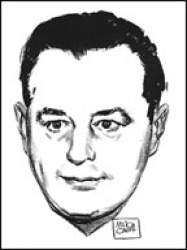Albert Francis Hegenberger
Major General, U.S. Air Force
Albert Francis Hegenberger was born on 30 September 1895 at Boston, MA. He attended Massachusetts Institute of Technology (MIT) and entered the Aviation Section of the U.S. Army Signal Corps as a Private on 14 September 1917.
Hegenberger graduated from the School of Military Aeronautics at MIT in December 1917, and that same month proceeded to Ellington Field, TX, where he earned his wings and received the rating of Reserve Military Aviator. He was commissioned as a Second Lieutenant in the Aviation Section of the Signal Reserve on 6 April 1918.
He then served successively at Camp Dick, Dallas, TX; School of Aerial Observers, Post Field, Fort Sill, OK; School of Aerial Gunnery, Taliaferro Field, TX; and Park Place, TX. In October 1918, he entered the School of Aeronautical Engineering at MIT.
Upon graduating in February 1919, he became Chief of the Instrument Branch at McCook Field in Dayton, OH. Subsequently, he served as Assistant Engineer of the Equipment Section of the Air Service Engineering Division at McCook Field. In the meantime, he was commissioned as a Second Lieutenant, Air Service, in the Regular Army on 1 July 1920.
He joined the 72nd Bombardment Squadron at Luke Field, HI, in October 1923 and later served as Operations Officer of the Fifth Composite Group. In March 1925, he was transferred to the 23rd Bombardment Squadron at Luke.
Returning to the mainland in October 1926, he became Chief of the Equipment Branch of the Air Corps Materiel Division at McCook Field. In July 1927, he was appointed Chief of the Instrument and Navigation Unit at McCook. He made the first solo blind flight (by instruments only) in1934, and developed the first instrument landing system.
He joined the 30th Bombardment Squadron at Rockwell Field, CA, in August 1935 and the following October became Commanding Officer of that Squadron. He later moved with this unit to March Field, CA, where he served until August 1937. He then enrolled in the Air Corps Tactical School at Maxwell Field. He graduated in June 1939, and was assigned to Hickam Field, HI, as Operations Officer of the Fifth Bombardment Group. In February 1940, he became Operations Officer of the 18th Wing at Hickam Field. He moved to Fort Shafter, HI, the following November to become Assistant Chief of Staff for operations of the Hawaiian Air Force, and in April 1941, was designated Commanding Officer of the 11th Bombardment Group at Hickam Field.
He subsequently commanded the l8th Bombardment Wing and the Seventh Bomber Command at Hickam Field until July 1942. From August to October 1942, he was Assistant Chief of Staff for Operations of the Second Air Force, and Commanding Officer of the Second Bomber Command at Fort George Wright, WA.
In October 1942, he assumed command of the 21st Bombardment Wing at Salina, KS, and later moved with that wing to Topeka Army Air Base, KS. In January 1944, he was assigned to duty with the Second Air Force at Colorado Springs, CO, as Chief of Staff. In January 1945, he was named Chief of Staff of the 14th Air Force in the China Theater of Operations. In August 1945, he became Commander of the 10th Air Force in the same Theater.
Returning to the U.S. in December 1945, he was assigned to Army Air Forces Headquarters for duty with the Officers Selection Committee. In July 1940, he went to PACUSA headquarters in Tokyo, Japan, and two months later became Commanding General of the First Air Division.
He returned to the U.S. in December 1947, and was assigned to U.S. Air Force Headquarters for duty with the Weapons Group, of which he later was appointed Chief. In July 1948, he was designated Assistant to the Assistant Deputy Chief of Staff, Operations, for Atomic Energy. He retired from the Air Force on 1 September 1949.
Medals and Awards
Distinguished Service Medal
Legion of Merit
Distinguished Flying Cross (2 Awards)
During his career, Hegenberger was rated as a Command Pilot, Combat Observer, and Aircraft Observer.
Honors
Hegenberger was inducted into the Aviation Hall of Fame.
Death and Burial
Major General Albert Francis Hegenberger died on 31 August 1983. He is buried at All Faiths Memorial Park in Casselberry, FL.










